The Canadian Mining Hall of Fame (CMHF) held its 35th annual induction ceremony on May 24 at the Carlu in Toronto, welcoming three new honourees, and bringing total membership up to 203.
The celebration, attended by around 530 people, was hosted by The Northern Miner Group’s president, Anthony Vaccaro. Full bios of all the inductees are available here.
Jim Cooney: A non-miner no longer
The first inductee of the night was Jim Cooney, who promoted the concept of sustainable development and encouraged the adoption of policies to improve mining’s environmental and social impacts.
In 1976, he was hired “as an outsider” by Cominco (now Teck Resources) as a researcher with the company’s strategic planning group. He would eventually become a leading advocate for sustainable development in mining, particularly at Placer Dome which became the first mining company to adopt a corporate sustainable development policy in 1997.
In a video interview, Cooney said his first assignment was to go to Tanzania to prepare a country risk assessment, a task he was given for his unique perspectives based on his study of political science at Georgetown University and Asian languages and philosophy at the University of Toronto. Those perspectives set him apart from most people in the business.
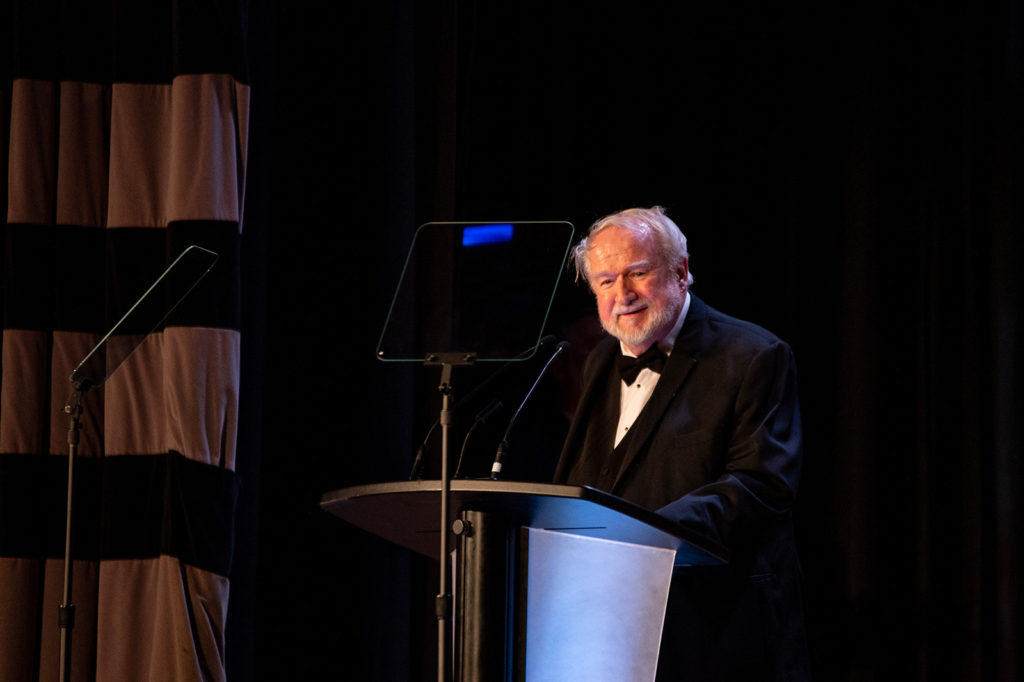
Jim Cooney is inducted into the Canadian Mining Hall of Fame. Credit: Morgan Hotston/CMHF
He was inspired by the UN’s Brundtland Commission’s 1987 report “Our Common Future,” which formally introduced sustainable development in its report. But, five years later when Cooney learned that no mining companies had attended the Rio Earth Summit, he realized the mining world was lagging behind.
“There was resistance to sustainable development when I first proposed it,” he said.
In a meeting with the World Bank in 1997, he introduced the concept of “social licence to operate” to explain the risk of conflicts between the mining industry and host communities. That concept has since spread throughout the industry.

Phillip John Mackey, who was inducted into the hall of fame in 2022, sits with his wife Angele at the gala dinner on May 25. Credit: Morgan Hotston/CMHF
Pierre Gratton, president and CEO of the Mining Association of Canada, spoke before he presented the award to Cooney. Gratton recalled how Cooney had inspired him in his first address to the Vancouver Board of Trade several years ago.
“Jim gave me the idea… on how our sector’s complexity calls for an immense diversity of talent, including even theologians and linguists like Jim,” Gratton said. “Sustainable mining, which is now being implemented in 13 countries worldwide continues to expand. It would not have been possible if there hadn’t been a Jim Cooney laying the groundwork for all of this work.”
In his acceptance speech, Cooney received roaring applause when told the audience the Hall of Fame event symbolizes that his transformation from non-miner to miner is complete.
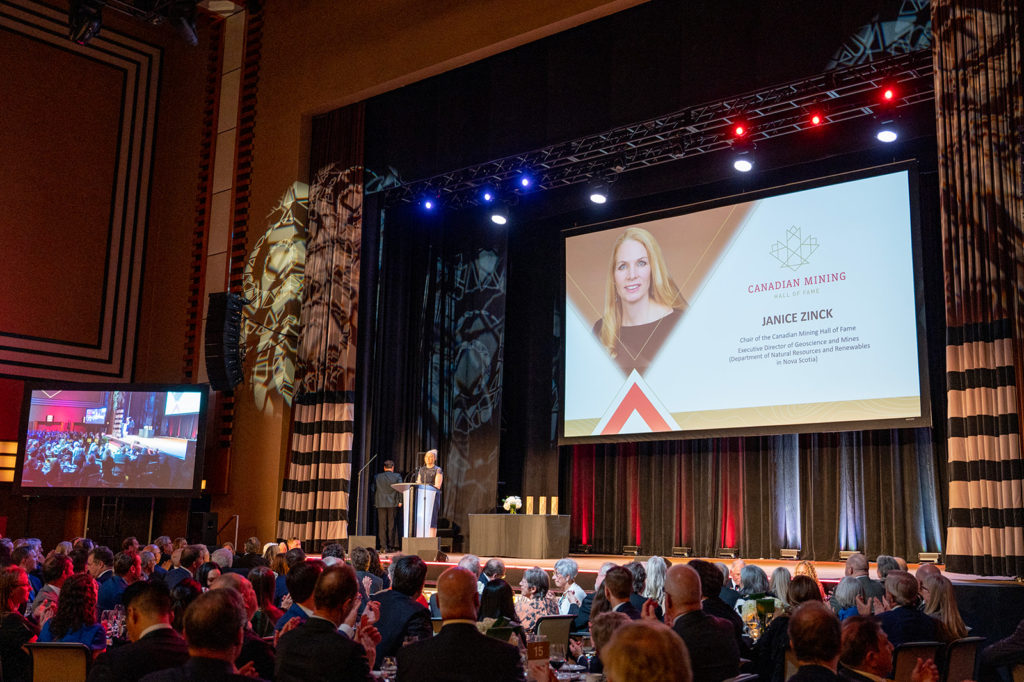
Janice Zinck, chair of the Canadian Mining Hall of Fame and executive director of Geoscience and Mines in the Department of Natural Resources and Renewables in Nova Scotia, welcomes attendees to the award ceremony. Caption: Morgan Hotston/CMHF
“My three children… were the primary motivators of my career in the mining industry, inspiring me to do whatever I could think of to stay employed, so essentially, I started thinking of sustainable development and social licence, and it worked. I kept my job!” he joked.
“Sustainable development essentially means that the economic, environmental and social dimensions of any industrial activity… must be continuously rebalanced and reintegrated, always with a focus on the long- term well-being of humanity and the planet. This means that the mining industry must engage in a never- ending effort to find compromise, and build consensus with those whose values and priorities differ from ours.”
While Cooney said he was alone in the industry when he first advocated for sustainable development and introduced social licence, he noted that he wasn’t alone for long.
He singled out John Wilson, CEO of Placer from 1993 to 2000, whose encouragement and enthusiasm made possible Cooney’s contributions to mining.
“I feel proud, very proud that Placer Dome became the first mining company to embrace sustainable development and social licence and that so many other mining companies individually and through their industry associations followed suit,” Cooney said. “This industry’s ability to redefine itself and adapt to changing expectations and demands is truly extraordinary.”
Douglas Balfour Silver: Infinitely curious
The second inductee was Douglas Balfour Silver, whose unique skills in valuations and appraisals helped improve due diligence in the mining industry, and he several highly valuable royalty portfolios in Canada.
Raised in New Jersey, Silver studied zoology and geology before completing a master’s degree in economic geology at the University of Arizona. Not one to sit still, Silver explained in a tribute video that he inherited a “genetic disorder” from his mother that makes him infinitely curious.
“I’ve switched about five or six times in different aspects of the mining industry, always because it just sounded more interesting or it was new, and I wanted change,” he said. “Change is good. I’ve always benefited from change.”
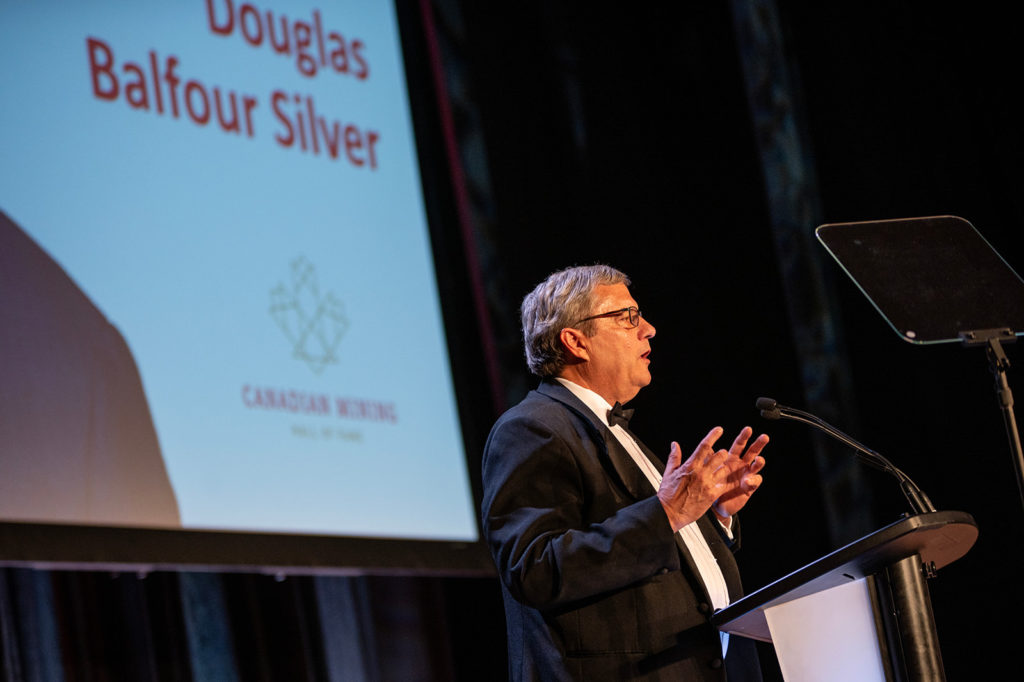
Douglas Balfour Silver is inducted into the Canadian Mining Hall of Fame. Credit: Morgan Hotston/CMHF
In 1987, he launched Colorado-based Balfour Holdings, and built comprehensive databases on mining issues as his fascination with data propelled him forward.
He recalled in a tribute video being one of the first discoverers of the high-grade Silver Creek molybdenum deposit in Colorado, although it was too deep to develop into a mine. He recounted how in those pre-computer days, his team spent eight months drawing isometric diagrams by hand trying to figure out where the deposit was.
“The thrill you get from making major mineral discoveries is like nothing else in the world. But what it did was put me on a path of thinking about doing things first. Your life is actually a series of firsts,” he said.
When the industry went into a downturn, Silver went back to school to study appraisal theory. He leveraged that education into Balfour Holdings.
“At the time, I don’t think there were five people in the world that had both a mining background and an appraisal background,” he said. “Balfour Holdings became a premier place for people to get appraisals because I had this dual skill set. It was a marvelous way to be very heavily embedded in the acquisition and mergers business.”
His foray into Canadian mining began with his founding of the Denver Gold Group in 1989, a forum to link gold companies with institutional investors.

2022 inductee Maureen C. Jensen was among the 530 people who attended this year’s event. Credit: Morgan Hotston/CMHF
Several years later, Silver joined private equity firm Orion Resource Partners, and built a royalty portfolio that eventually sold for $1.1 billion to Osisko Gold Royalties, one of the largest royalty transactions ever.
But Silver’s career has been about more than big deals. He has always valued education and people, making donations to higher education in the mineral sector, as well as time and effort to mentoring students. He has also supported the advancement of women in mining.
“That never made sense to me about this glass ceiling,” he said in a video. “Women can multitask and one industry that needs multitasking is mining. We’re seeing a lot more women CEOs, we’re seeing a lot more women on boards, but it’s been long overdue, and I did what I could to break the glass.”
After TNM’s Vaccaro presented the award to Silver, he said he’s been a closet Canadian for decades and the CMHF gala is his coming out party.
“There are more public mineral and mining companies in Canada than anywhere else in the world. This is like… winning an Olympic gold medal in hockey and dare I say against the Americans.”
Silver closed by thanking his ex-wife for raising their children, allowing him the freedom to do the work that made him successful.
“I think a lot of times recipients of awards don’t appreciate what their significant others do for them. Thank you and for all the significant others regardless of pronoun, thank you.”
Alexander John Davidson: From the bush to the biggest deposits in Peru
Alex Davidson, the final inductee of 2023, has been behind the discovery of major deposits in Canada and South America, and his leadership within Barrick Gold helped advance the company into the world’s leading gold producer.
Born in Montreal, Davidson graduated from McGill University in 1976 with a M.Sc. degree in economic geology.
His drive to apply geology in a hands-on way soon took him to an exploration project in northern Quebec, where Indigenous people taught him how to survive in the bush.
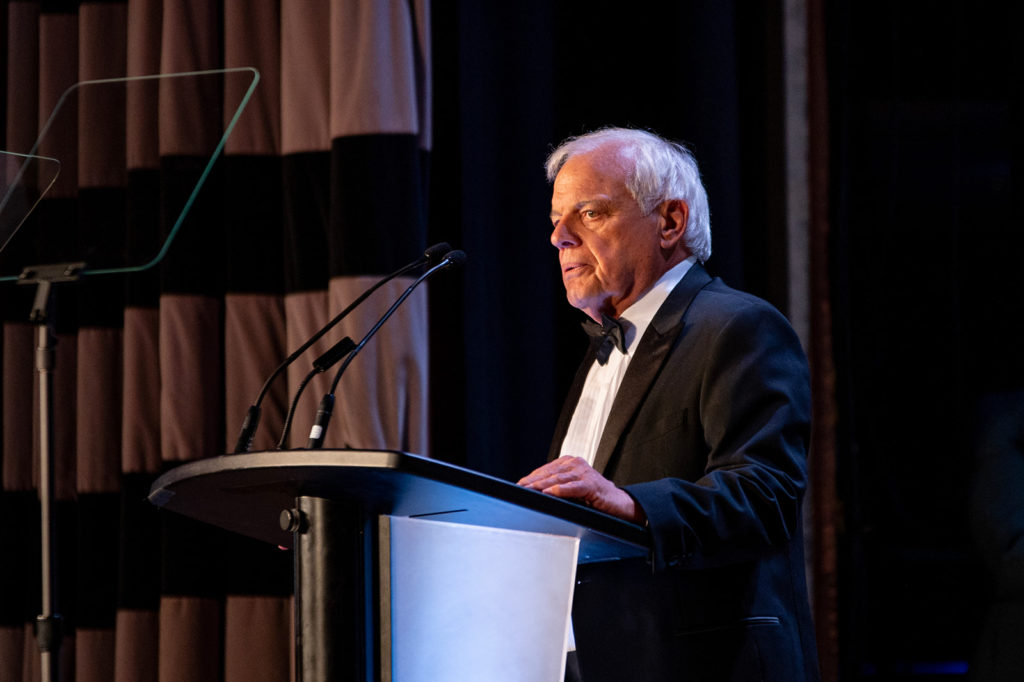
Alex Davidson is inducted into the Canadian Mining Hall of Fame. Credit: Morgan Hotston/CMHF
“They taught me how to capture rabbits with a snare, fish with a broken line, never wash because the soap attracts mosquitoes, black flies and deer flies, and also how to strike a tent and put up camp in the rain. It was an invaluable exercise,” he recalled in a tribute video.
Not long after, he was leading an exploration program for a predecessor of Cameco in Saskatchewan’s Athabasca Basin, where his team drilled the discovery hole at the McArthur Lake uranium deposit.
After joining Falconbridge Copper in Ontario in 1980, Davidson helped discover the high-grade Winston Lake zinc deposit, which produced from 1988 to 1999.
His success led him to Barrick in 1993, a firm that he described as very small but with big ambitions, and led at the time by CMHF inductees Peter Munk and Robert Smith.
“That’s why we went down to Peru. It was a very motivated team and it was a lot of fun to work there,” Davidson said.
After the company discovered the Pierina deposit in Peru, Davidson’s team found the even-larger Lagunas Norte deposit. It eventually produced more than 10 million oz. of gold.

Patricia Dillon, who was inducted into the hall of fame in 2021 also attended the May 25 ceremony. Credit: Morgan Hotston/CMHF
His work helped raise the profile of Canadian mining and earned him the Prospectors and Developers Association of Canada’s Prospector of the Year Award in 2003, the Canadian Institute of Mining, Metallurgy and Petroleum’s A.O. Dufresne Award in 2005 and the Society for Mining, Metallurgy and Exploration’s Charles F. Rand Gold Medal in 2019.
After accepting his award onstage, Davidson noted the rich history of mining in Canada and its contribution to employment and as a driver of innovation, technology and sustainability.
“I’m proud to be part of an industry that has had such a positive impact on the lives of people not only here in Canada, but around the world,” he said.
While he acknowledged that some of the largest historical Canadian mining companies like Falconbridge, Noranda and Alcan are gone, Davidson said their important components are still here.
“We didn’t lose their orebodies or their mines. They didn’t move an inch. We didn’t lose their people either.
“Here in Canada, we have an amazing ability to create new wealth, with many new successful companies doing excellent exploration. Just think about how many new mining companies we’ve created and how many new mines we have found here in Canada… since the Leafs last won the Stanley Cup.”
A key path to keeping the industry alive is education, a cause that Davidson and his wife Gillian champion through their $1-million Alex and Gillian Davidson Family Endowment for Indigenous Students in Canada.
“I think Indigenous students can become strong proponents of and indeed leaders of its industry, but we have to provide the means for those students to get through their studies.”

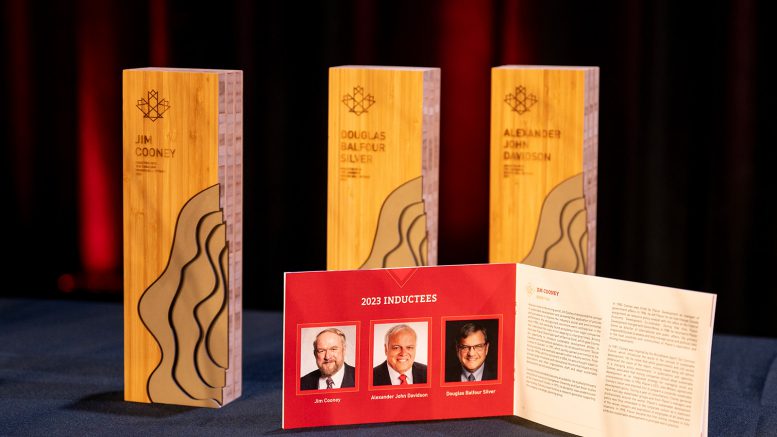
Be the first to comment on "Canadian Mining Hall of Fame looks to the future with newest inductees"